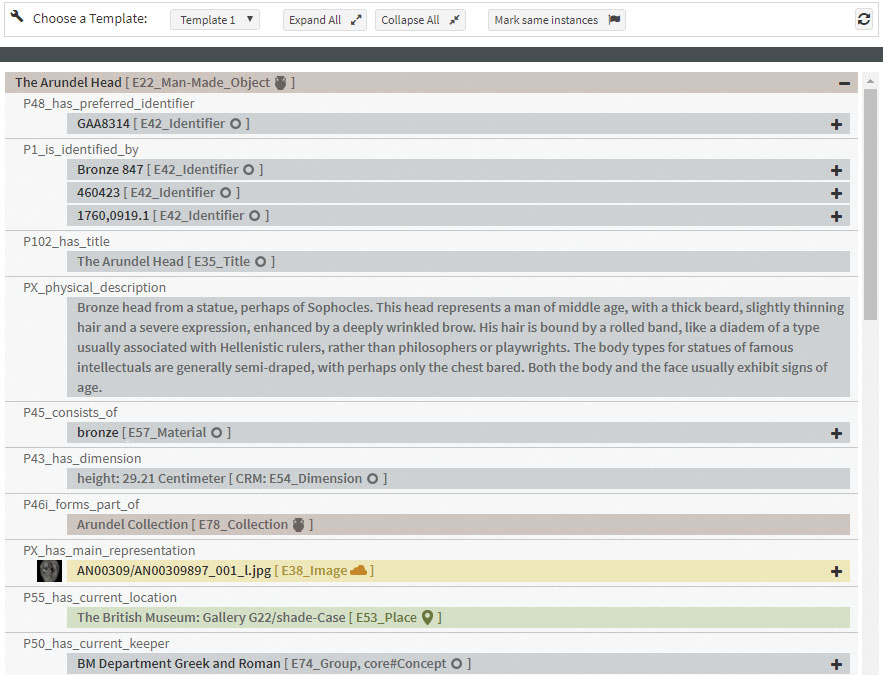by Nikos Minadakis, Kostas Petrakis, Korina Doerr and Martin Doerr (FORTH)
RDF Visualiser is a generic browsing mechanism that gives the user a flexible, highly configurable, detailed overview of an RDF dataset / database, designed and developed to overcome the drawbacks of the existing RDF data visualisation methods/tools. RDFV is currently used in EU research projects by the 3M editor of the X3ML suite of tools and has been tested with large datasets from the British Museum and the American Art Collaborative project.
RDF is widely used for data integration, transformation and aggregation of heterogeneous sources and applications of mappings between the source schemata. Although a great deal of emphasis has been placed on the validation of the produced RDF structure and format, the efficient visualisation of the constructed database contents that enables semantic validation by domain experts has largely been ignored and is achieved either by manual inspection of multiple files, by formulation and execution of complex SPARQL queries, or by custom user interfaces that work only with a particular RDF schema without intervention by a programmer.
The basic principles that an efficient and user-friendly RDF data visualisation tool should be able to live up to are:
- The ability to display data of any schema and RDF format.
- The ability to display all nodes of any class/instance.
- The application of configuration rules to improve the layout or presentation for known classes and properties (e.g., hide URIs that are meaningless for the user).
- The display of a high density of information in one screen (which is not possible in solutions based on “object templates”).
Although some visualisation solutions already exist and have been applied to successful projects [L1],[1], the existing approaches fail to fulfil the complete set of principles enumerated above. Specifically, approaches that display all the nodes of any class/schema and support any schema and format (principles 1 and 2) fail to display a high density of information in one screen and those that succeed with regards to the latter fail in relation to the rest of the principles.
In order to meet the requirements laid out by the complete set of principles, our team designed and implemented the RDF Visualiser (RDFV), a generic browsing mechanism that gives the user a flexible, highly configurable, detailed overview of an RDF dataset / database.
RDFV presents RDF data as an indented list to handle the density and depth of information (principle 4) starting from a specified RDF resource (URI). In order to achieve this, all incoming links are inverted to display all the nodes of every class/instance (principle 2) in a schema agnostic way (principle 1). Users are able to configure the display of schema-dependent information according to their preferences (principle 4). By editing an xml file, users are also able to define priority based rule chains that are used to define schema-dependent style and order of properties that are inherited to subclasses and subproperties (principle 4). For anything not covered by a rule, default options are applied based on our experience and best practices. The user interface of the tool has been designed in cooperation with potential users, with a focus on usability and readability (Figure 1).

Figure 1: RDFV user interface.
Moreover, rich functions are provided to the user to control the display of data items, such as identifying same instances, expanding collapsing big texts or big sets of results, selecting the maximal depth of information, displaying images and image galleries, removing prefixes, selecting non displayed URIs, retrieving the path of the sub-graph for a specific node etc.
RDFV supports browsing of content in triple stores (tested successfully on Virtuoso and BlazeGraph) and in local files of every format. It has been integrated in the 3M interface of the X3ML suite of tools for data mapping and transformation [2]. Added into the 3M interface it adds an important validation tool for data mapped and transformed by domain experts who wish to check and correct the resulting outputs, enabling an iterative and collaborative evaluation of the resultant RDF. RDFV is currently exploited by a number of EU research projects, and has been tested with large RDF datasets from the British Museum and from the American Art Collaborative project.
In the future RDFV will support geospatial display functions on maps along with a new refined set of the existing functions with a focus on configurability and personalisation.
Our team will continue to work on the development, maintenance and user support of RDFV. The RDFV components, which consist of API microservices and a web application, are also available as independent blocks to assist developers with building their own applications through GitHub by September 2017.
Link:
[L1] http://www.researchspace.org/
References:
[1] N. Minadakis, et al.: “LifeWatch Greece Data-Services: On Supporting Metadata and Semantics Integration for the Biodiversity Domain”, in 13th International Congress on the Zoogeography and Ecology of Greece and Adjacent Regions (ICZEGAR’2015), Heraklion, Crete, October 2015.
[2] Y. Marketakis, et al.: “X3ML Mapping Framework for Information Integration in Cultural Heritage and beyond”, International Journal on Digital Libraries, pp 1-19, Springer, DOI 10.1007/s00799-016-0179-1.
Please contact:
Minadakis Nikos, FORTH, Greece











